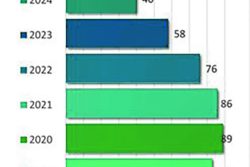A recent document emanating from the Ministry of Agriculture titled ‘The Agriculture Sector – Achievements for 2022,’ alludes to some of the sectorial assignments with which the Ministry was associated in 2022. In many, perhaps even most instances, the document did no more than allude to undertakings in which it was involved, either on its own or as part of domestic or regional partnerships. In those instances it simply stated that one or another activity had occurred, providing few or simply no details about the substantive progress that had been recorded in pursuit of the respective goals. One wonders, therefore, whether the Ministry’s application of the phrase “Achievements for 2022” was not, in fact, a misapplication at least in some instances. If no one can blame the Ministry of Agriculture for blowing its trumpet in the matter of what it perceives to be the weightiness of its 2022 timetable, it must be mindful that its eagerness to do so does not extend into causing its pronouncements to be seen as trumpeting much louder than merited.
One of the more important undertakings in which the Ministry was involved in 2022 was the collaboration with entities in other countries in the region, including, particularly, Barbados, in the creation of what the Ministry describes as “the Guyana-Barbados Food Terminal. The Terminal will, the Ministry of Agriculture’s pronouncement says, also be supporting “the movement of products and reducing the cost of local produce, while also providing the opportunity to access new markets.”
Here, it should be noted that shortly after the disclosure on the Food Terminal was made there came the disclosure of instances of food insecurity in some of the smaller territories in the region, a development that may well have caught some of us in the Caribbean by surprise since, while the food production capabilities of countries in the region had always been known to vary from country to country, the issue of food insecurity in the region, in the sense that the phrase is used, had never been known to be a matter of imminent and critical concern in the region.
Shockingly, when the disclosure was made by the World Bank back in September last year that “the Caribbean region, already hit by the COVID-19 pandemic and struggling with the impact of the climate crisis, now faces another serious problem: a food crisis,” the news would have come as a surprise to those of us who had long conceptualized the notion of food insecurity as applying to other distant, impoverished regions of the world. The World Bank’s September 2022 disclosure on food insecurity in the Caribbean had the effect of further illuminating the significance to the agreed Regional Food Terminal, the creation of which, it seemed, had mostly been assigned to Guyana and Barbados. It appeared that the actual creation of what had been described as the ‘food security hub’ was assigned largely to Barbados whilst the broader logistical considerations that include the movement of food across the region would be a shared responsibility. Food production (or much of it) unsurprisingly, would be the responsibility of Guyana.
The announcement of the Food Security Terminal project coincided with news of worsening food availability concerns in parts of the Caribbean coupled with seeming increasing concern about the volumes of food being imported into the region mostly by the territories whose economies depended largely on tourism. It had become clear not only that the costs associated with food imports had become patently unaffordable and therefore unsustainable for the ‘tourist territories’ but that the extent of the attendant emergency meant that the situation had to be addressed as a matter of emergency.
It is out of this complex set of circumstances that emerged the regional decision to set the Caribbean a target year of 2025 for a 25% reduction in extra regional food imports. Significantly, it remains unclear as to whether those territories that are heavily tourism-dependent are at one with the region on the 25 x 2025 issue.
Not only is Guyana a decided exception to that conundrum, but, as well, it has a critical role to play in both the Food Terminal and the 25 x 2025 undertakings.
Two points should be made (and here is where we can justifiably look to the Ministry of Agriculture for answers) at this juncture. First, there is need at this stage for a region-wide update on the state of play in the matter of the establishment of the Food Terminal, the earliest announcements of which were made back in May last year. Two regional Heads of Government, President Irfaan Ali and Prime Minister Mia Mottley have the major responsibilities here. Secondly, there is the issue of working out the ‘mechanics’ of just how we are going to get to the targets of 25% by 2025. Here, one would imagine, there is a broader CARICOM responsibility that is sufficiently important to cause the exercise to be put before the best experts in the region and for them to be set particular timelines for reporting to the region on just how we go about meeting that timeline.
` The Agriculture Sector – Achievements for 2022’ document, cannot, by any stretch of the imagination, be accurately deemed to be a catalogue of achievements, Here, the Ministry must remind itself that, going forward, much will be expected of it, both locally and regionally, if the Caribbean’s food security credentials are to be protected.







